Electrical Engineering: Differential Equations Homework Solutions
VerifiedAdded on 2023/06/03
|10
|2205
|298
Homework Assignment
AI Summary
This document provides detailed solutions to a series of differential equations problems. The solutions utilize Lyapunov functions to analyze the stability of equilibrium points in various systems. The problems cover a range of scenarios, including both linear and nonlinear systems. Each solution includes the application of Lyapunov's direct method to determine the stability properties such as global asymptotic stability or instability. The analysis also considers concepts like exponential stability, and the boundedness of solutions. The document includes a reference list of relevant literature. The provided solutions are intended to aid in understanding of differential equations and related concepts.
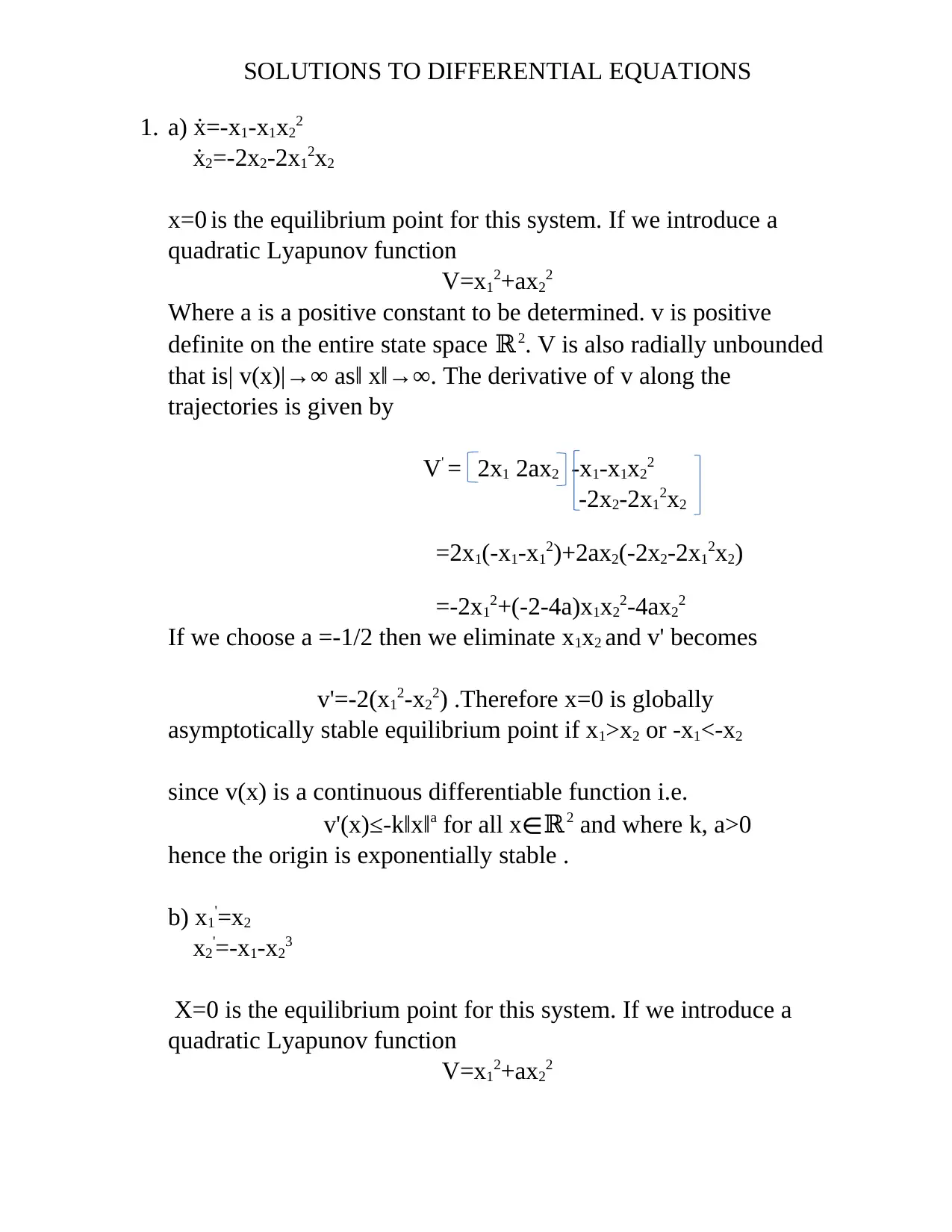
SOLUTIONS TO DIFFERENTIAL EQUATIONS
1. a) ẋ=-x1-x1x22
ẋ2=-2x2-2x12x2
x=0 is the equilibrium point for this system. If we introduce a
quadratic Lyapunov function
V=x12+ax22
Where a is a positive constant to be determined. v is positive
definite on the entire state space ℝ2. V is also radially unbounded
that is| v(x)|→∞ as‖ x‖→∞. The derivative of v along the
trajectories is given by
V' = 2x1 2ax2 -x1-x1x22
-2x2-2x12x2
=2x1(-x1-x12)+2ax2(-2x2-2x12x2)
=-2x12+(-2-4a)x1x22-4ax22
If we choose a =-1/2 then we eliminate x1x2 and v' becomes
v'=-2(x12-x22) .Therefore x=0 is globally
asymptotically stable equilibrium point if x1>x2 or -x1<-x2
since v(x) is a continuous differentiable function i.e.
v'(x)≤-k‖x‖a for all x∊ℝ2 and where k, a>0
hence the origin is exponentially stable .
b) x1'=x2
x2'=-x1-x23
X=0 is the equilibrium point for this system. If we introduce a
quadratic Lyapunov function
V=x12+ax22
1. a) ẋ=-x1-x1x22
ẋ2=-2x2-2x12x2
x=0 is the equilibrium point for this system. If we introduce a
quadratic Lyapunov function
V=x12+ax22
Where a is a positive constant to be determined. v is positive
definite on the entire state space ℝ2. V is also radially unbounded
that is| v(x)|→∞ as‖ x‖→∞. The derivative of v along the
trajectories is given by
V' = 2x1 2ax2 -x1-x1x22
-2x2-2x12x2
=2x1(-x1-x12)+2ax2(-2x2-2x12x2)
=-2x12+(-2-4a)x1x22-4ax22
If we choose a =-1/2 then we eliminate x1x2 and v' becomes
v'=-2(x12-x22) .Therefore x=0 is globally
asymptotically stable equilibrium point if x1>x2 or -x1<-x2
since v(x) is a continuous differentiable function i.e.
v'(x)≤-k‖x‖a for all x∊ℝ2 and where k, a>0
hence the origin is exponentially stable .
b) x1'=x2
x2'=-x1-x23
X=0 is the equilibrium point for this system. If we introduce a
quadratic Lyapunov function
V=x12+ax22
Paraphrase This Document
Need a fresh take? Get an instant paraphrase of this document with our AI Paraphraser
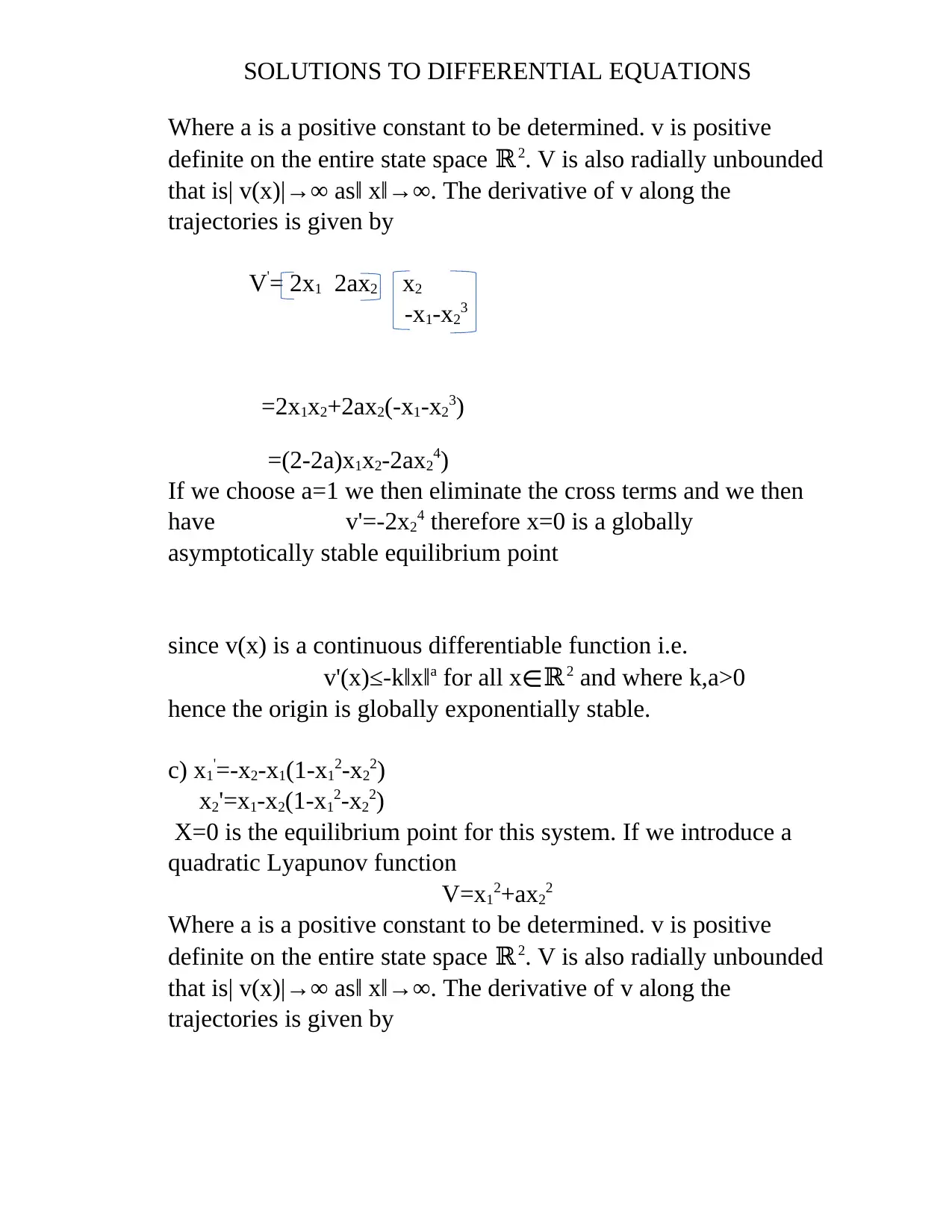
SOLUTIONS TO DIFFERENTIAL EQUATIONS
Where a is a positive constant to be determined. v is positive
definite on the entire state space ℝ2. V is also radially unbounded
that is| v(x)|→∞ as‖ x‖→∞. The derivative of v along the
trajectories is given by
V'= 2x1 2ax2 x2
-x1-x23
=2x1x2+2ax2(-x1-x23)
=(2-2a)x1x2-2ax24)
If we choose a=1 we then eliminate the cross terms and we then
have v'=-2x24 therefore x=0 is a globally
asymptotically stable equilibrium point
since v(x) is a continuous differentiable function i.e.
v'(x)≤-k‖x‖a for all x∊ℝ2 and where k,a>0
hence the origin is globally exponentially stable.
c) x1'=-x2-x1(1-x12-x22)
x2'=x1-x2(1-x12-x22)
X=0 is the equilibrium point for this system. If we introduce a
quadratic Lyapunov function
V=x12+ax22
Where a is a positive constant to be determined. v is positive
definite on the entire state space ℝ2. V is also radially unbounded
that is| v(x)|→∞ as‖ x‖→∞. The derivative of v along the
trajectories is given by
Where a is a positive constant to be determined. v is positive
definite on the entire state space ℝ2. V is also radially unbounded
that is| v(x)|→∞ as‖ x‖→∞. The derivative of v along the
trajectories is given by
V'= 2x1 2ax2 x2
-x1-x23
=2x1x2+2ax2(-x1-x23)
=(2-2a)x1x2-2ax24)
If we choose a=1 we then eliminate the cross terms and we then
have v'=-2x24 therefore x=0 is a globally
asymptotically stable equilibrium point
since v(x) is a continuous differentiable function i.e.
v'(x)≤-k‖x‖a for all x∊ℝ2 and where k,a>0
hence the origin is globally exponentially stable.
c) x1'=-x2-x1(1-x12-x22)
x2'=x1-x2(1-x12-x22)
X=0 is the equilibrium point for this system. If we introduce a
quadratic Lyapunov function
V=x12+ax22
Where a is a positive constant to be determined. v is positive
definite on the entire state space ℝ2. V is also radially unbounded
that is| v(x)|→∞ as‖ x‖→∞. The derivative of v along the
trajectories is given by
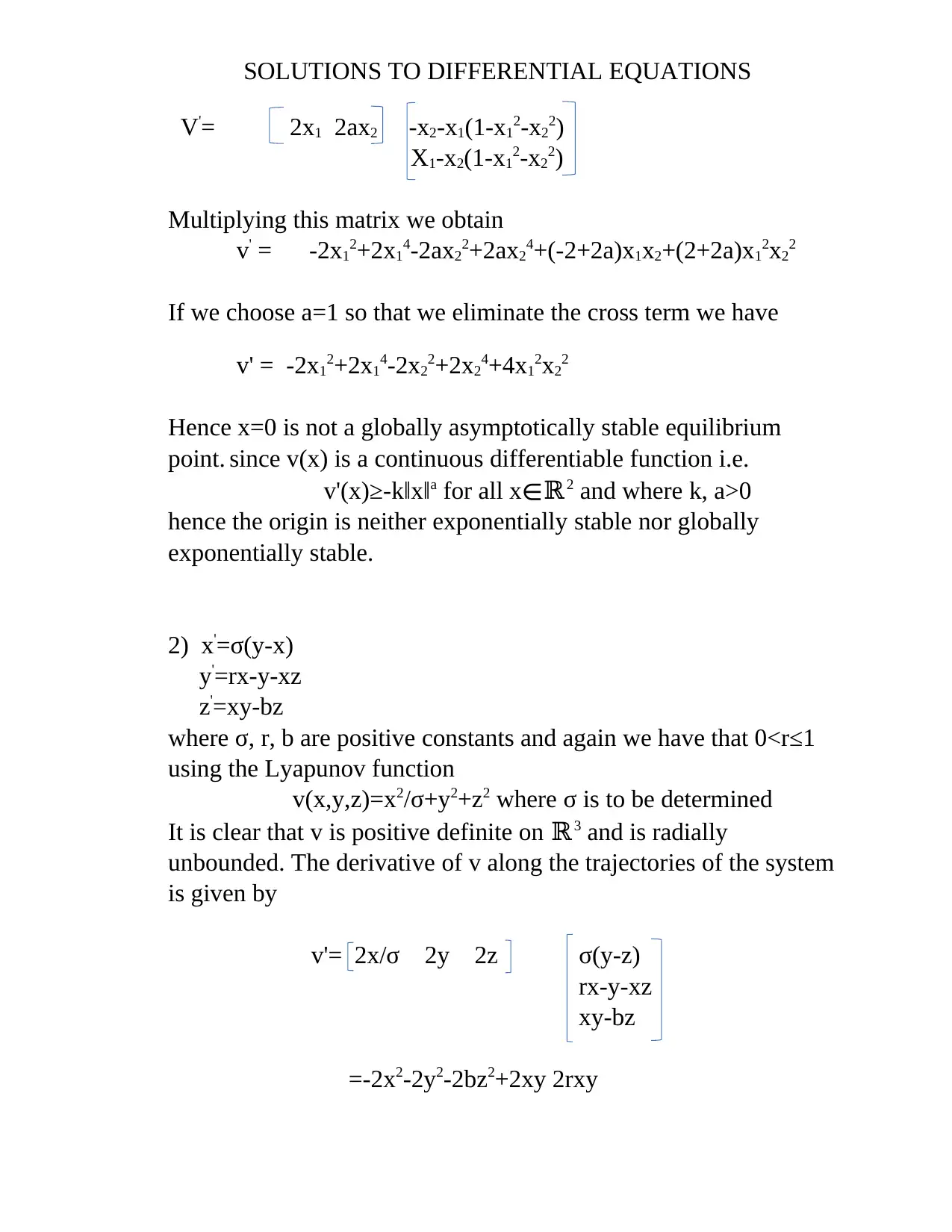
SOLUTIONS TO DIFFERENTIAL EQUATIONS
V'= 2x1 2ax2 -x2-x1(1-x12-x22)
X1-x2(1-x12-x22)
Multiplying this matrix we obtain
v' = -2x12+2x14-2ax22+2ax24+(-2+2a)x1x2+(2+2a)x12x22
If we choose a=1 so that we eliminate the cross term we have
v' = -2x12+2x14-2x22+2x24+4x12x22
Hence x=0 is not a globally asymptotically stable equilibrium
point. since v(x) is a continuous differentiable function i.e.
v'(x)≥-k‖x‖a for all x∊ℝ2 and where k, a>0
hence the origin is neither exponentially stable nor globally
exponentially stable.
2) x'=σ(y-x)
y'=rx-y-xz
z'=xy-bz
where σ, r, b are positive constants and again we have that 0<r≤1
using the Lyapunov function
v(x,y,z)=x2/σ+y2+z2 where σ is to be determined
It is clear that v is positive definite on ℝ3 and is radially
unbounded. The derivative of v along the trajectories of the system
is given by
v'= 2x/σ 2y 2z σ(y-z)
rx-y-xz
xy-bz
=-2x2-2y2-2bz2+2xy 2rxy
V'= 2x1 2ax2 -x2-x1(1-x12-x22)
X1-x2(1-x12-x22)
Multiplying this matrix we obtain
v' = -2x12+2x14-2ax22+2ax24+(-2+2a)x1x2+(2+2a)x12x22
If we choose a=1 so that we eliminate the cross term we have
v' = -2x12+2x14-2x22+2x24+4x12x22
Hence x=0 is not a globally asymptotically stable equilibrium
point. since v(x) is a continuous differentiable function i.e.
v'(x)≥-k‖x‖a for all x∊ℝ2 and where k, a>0
hence the origin is neither exponentially stable nor globally
exponentially stable.
2) x'=σ(y-x)
y'=rx-y-xz
z'=xy-bz
where σ, r, b are positive constants and again we have that 0<r≤1
using the Lyapunov function
v(x,y,z)=x2/σ+y2+z2 where σ is to be determined
It is clear that v is positive definite on ℝ3 and is radially
unbounded. The derivative of v along the trajectories of the system
is given by
v'= 2x/σ 2y 2z σ(y-z)
rx-y-xz
xy-bz
=-2x2-2y2-2bz2+2xy 2rxy
⊘ This is a preview!⊘
Do you want full access?
Subscribe today to unlock all pages.

Trusted by 1+ million students worldwide
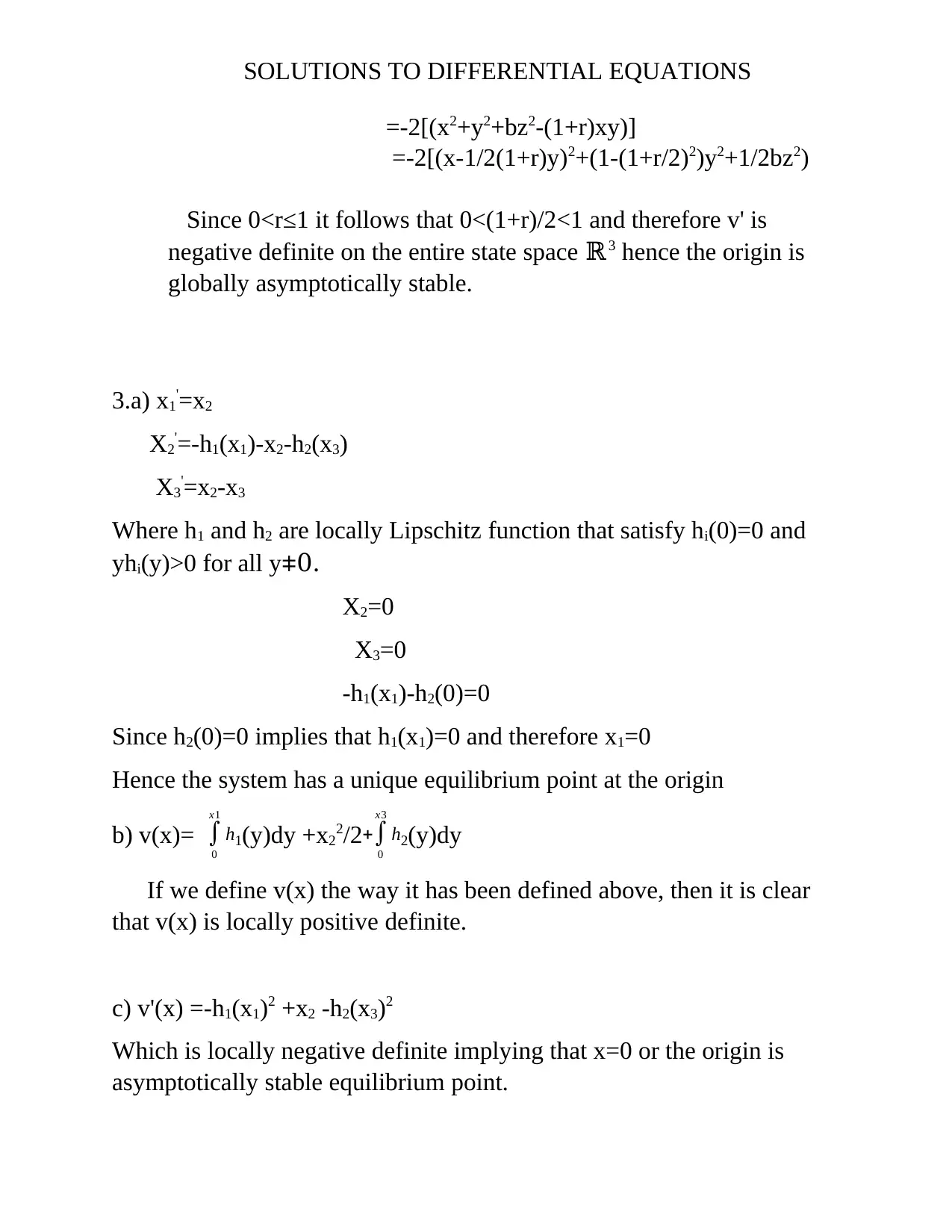
SOLUTIONS TO DIFFERENTIAL EQUATIONS
=-2[(x2+y2+bz2-(1+r)xy)]
=-2[(x-1/2(1+r)y)2+(1-(1+r/2)2)y2+1/2bz2)
Since 0<r≤1 it follows that 0<(1+r)/2<1 and therefore v' is
negative definite on the entire state space ℝ3 hence the origin is
globally asymptotically stable.
3.a) x1'=x2
X2'=-h1(x1)-x2-h2(x3)
X3'=x2-x3
Where h1 and h2 are locally Lipschitz function that satisfy hi(0)=0 and
yhi(y)>0 for all y 0.⧧
X2=0
X3=0
-h1(x1)-h2(0)=0
Since h2(0)=0 implies that h1(x1)=0 and therefore x1=0
Hence the system has a unique equilibrium point at the origin
b) v(x)= ∫
0
x1
h1(y)dy +x22/2+∫
0
x3
h2(y)dy
If we define v(x) the way it has been defined above, then it is clear
that v(x) is locally positive definite.
c) v'(x) =-h1(x1)2 +x2 -h2(x3)2
Which is locally negative definite implying that x=0 or the origin is
asymptotically stable equilibrium point.
=-2[(x2+y2+bz2-(1+r)xy)]
=-2[(x-1/2(1+r)y)2+(1-(1+r/2)2)y2+1/2bz2)
Since 0<r≤1 it follows that 0<(1+r)/2<1 and therefore v' is
negative definite on the entire state space ℝ3 hence the origin is
globally asymptotically stable.
3.a) x1'=x2
X2'=-h1(x1)-x2-h2(x3)
X3'=x2-x3
Where h1 and h2 are locally Lipschitz function that satisfy hi(0)=0 and
yhi(y)>0 for all y 0.⧧
X2=0
X3=0
-h1(x1)-h2(0)=0
Since h2(0)=0 implies that h1(x1)=0 and therefore x1=0
Hence the system has a unique equilibrium point at the origin
b) v(x)= ∫
0
x1
h1(y)dy +x22/2+∫
0
x3
h2(y)dy
If we define v(x) the way it has been defined above, then it is clear
that v(x) is locally positive definite.
c) v'(x) =-h1(x1)2 +x2 -h2(x3)2
Which is locally negative definite implying that x=0 or the origin is
asymptotically stable equilibrium point.
Paraphrase This Document
Need a fresh take? Get an instant paraphrase of this document with our AI Paraphraser
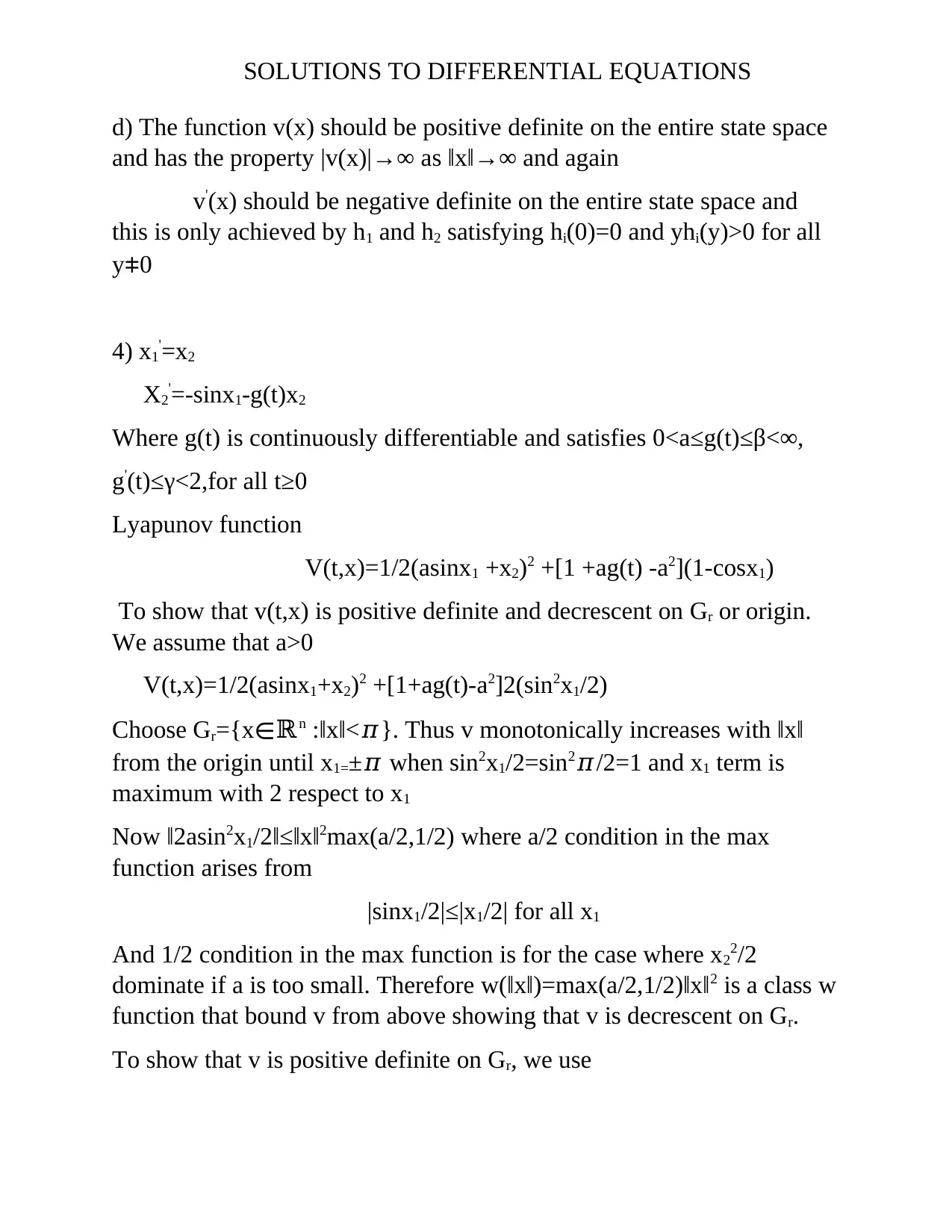
SOLUTIONS TO DIFFERENTIAL EQUATIONS
d) The function v(x) should be positive definite on the entire state space
and has the property |v(x)|→∞ as ‖x‖→∞ and again
v'(x) should be negative definite on the entire state space and
this is only achieved by h1 and h2 satisfying hi(0)=0 and yhi(y)>0 for all
y⧧0
4) x1'=x2
X2'=-sinx1-g(t)x2
Where g(t) is continuously differentiable and satisfies 0<a≤g(t)≤β<∞,
g'(t)≤γ<2,for all t≥0
Lyapunov function
V(t,x)=1/2(asinx1 +x2)2 +[1 +ag(t) -a2](1-cosx1)
To show that v(t,x) is positive definite and decrescent on Gr or origin.
We assume that a>0
V(t,x)=1/2(asinx1+x2)2 +[1+ag(t)-a2]2(sin2x1/2)
Choose Gr={x∊ℝn :‖x‖<𝜋}. Thus v monotonically increases with ‖x‖
from the origin until x1=±𝜋 when sin2x1/2=sin2𝜋/2=1 and x1 term is
maximum with 2 respect to x1
Now ‖2asin2x1/2‖≤‖x‖2max(a/2,1/2) where a/2 condition in the max
function arises from
|sinx1/2|≤|x1/2| for all x1
And 1/2 condition in the max function is for the case where x22/2
dominate if a is too small. Therefore w(‖x‖)=max(a/2,1/2)‖x‖2 is a class w
function that bound v from above showing that v is decrescent on Gr.
To show that v is positive definite on Gr, we use
d) The function v(x) should be positive definite on the entire state space
and has the property |v(x)|→∞ as ‖x‖→∞ and again
v'(x) should be negative definite on the entire state space and
this is only achieved by h1 and h2 satisfying hi(0)=0 and yhi(y)>0 for all
y⧧0
4) x1'=x2
X2'=-sinx1-g(t)x2
Where g(t) is continuously differentiable and satisfies 0<a≤g(t)≤β<∞,
g'(t)≤γ<2,for all t≥0
Lyapunov function
V(t,x)=1/2(asinx1 +x2)2 +[1 +ag(t) -a2](1-cosx1)
To show that v(t,x) is positive definite and decrescent on Gr or origin.
We assume that a>0
V(t,x)=1/2(asinx1+x2)2 +[1+ag(t)-a2]2(sin2x1/2)
Choose Gr={x∊ℝn :‖x‖<𝜋}. Thus v monotonically increases with ‖x‖
from the origin until x1=±𝜋 when sin2x1/2=sin2𝜋/2=1 and x1 term is
maximum with 2 respect to x1
Now ‖2asin2x1/2‖≤‖x‖2max(a/2,1/2) where a/2 condition in the max
function arises from
|sinx1/2|≤|x1/2| for all x1
And 1/2 condition in the max function is for the case where x22/2
dominate if a is too small. Therefore w(‖x‖)=max(a/2,1/2)‖x‖2 is a class w
function that bound v from above showing that v is decrescent on Gr.
To show that v is positive definite on Gr, we use
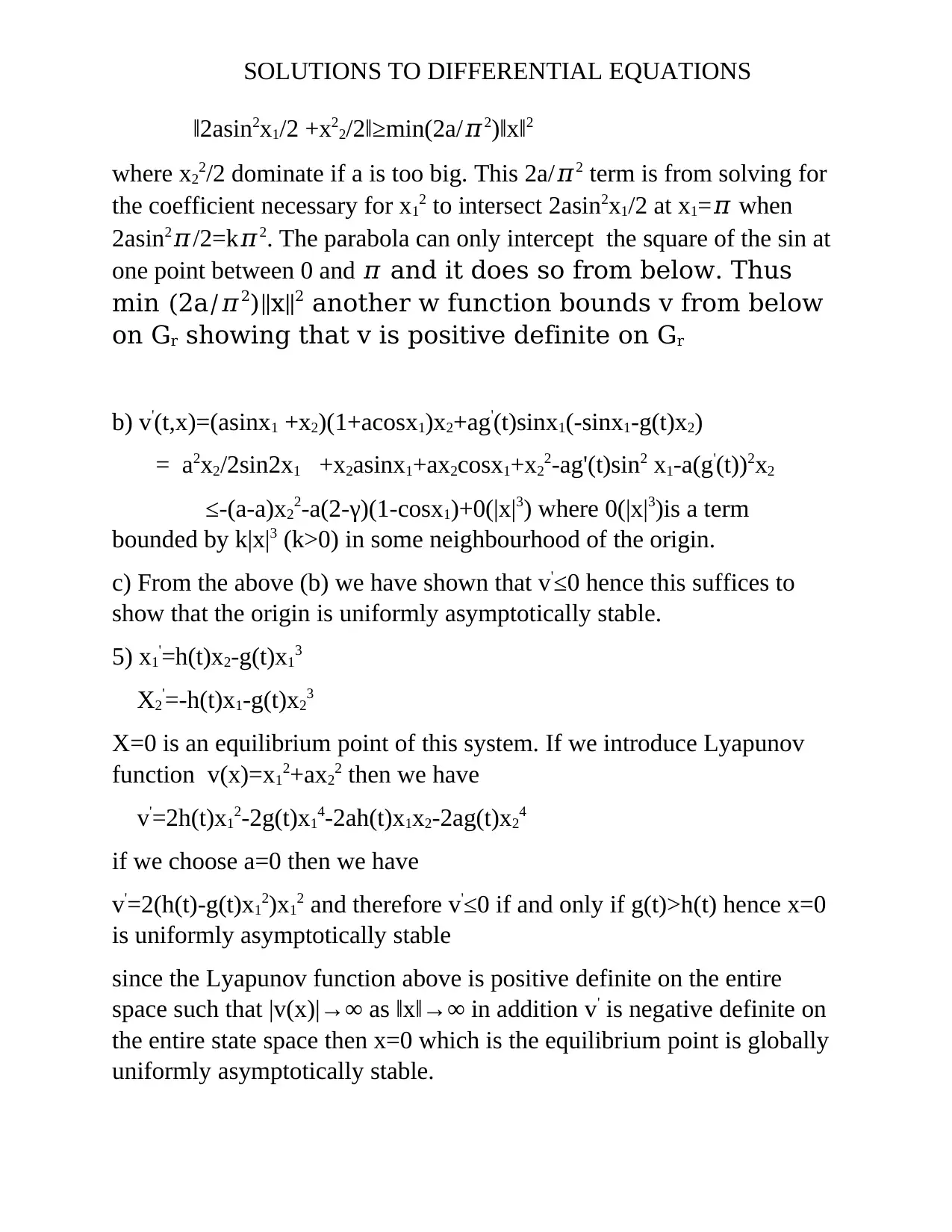
SOLUTIONS TO DIFFERENTIAL EQUATIONS
‖2asin2x1/2 +x22/2‖≥min(2a/𝜋2)‖x‖2
where x22/2 dominate if a is too big. This 2a/𝜋2 term is from solving for
the coefficient necessary for x12 to intersect 2asin2x1/2 at x1=𝜋 when
2asin2𝜋/2=k𝜋2. The parabola can only intercept the square of the sin at
one point between 0 and 𝜋 and it does so from below. Thus
min (2a/𝜋2)‖x‖2 another w function bounds v from below
on Gr showing that v is positive definite on Gr
b) v'(t,x)=(asinx1 +x2)(1+acosx1)x2+ag'(t)sinx1(-sinx1-g(t)x2)
= a2x2/2sin2x1 +x2asinx1+ax2cosx1+x22-ag'(t)sin2 x1-a(g'(t))2x2
≤-(a-a)x22-a(2-γ)(1-cosx1)+0(|x|3) where 0(|x|3)is a term
bounded by k|x|3 (k>0) in some neighbourhood of the origin.
c) From the above (b) we have shown that v'≤0 hence this suffices to
show that the origin is uniformly asymptotically stable.
5) x1'=h(t)x2-g(t)x13
X2'=-h(t)x1-g(t)x23
X=0 is an equilibrium point of this system. If we introduce Lyapunov
function v(x)=x12+ax22 then we have
v'=2h(t)x12-2g(t)x14-2ah(t)x1x2-2ag(t)x24
if we choose a=0 then we have
v'=2(h(t)-g(t)x12)x12 and therefore v'≤0 if and only if g(t)>h(t) hence x=0
is uniformly asymptotically stable
since the Lyapunov function above is positive definite on the entire
space such that |v(x)|→∞ as ‖x‖→∞ in addition v' is negative definite on
the entire state space then x=0 which is the equilibrium point is globally
uniformly asymptotically stable.
‖2asin2x1/2 +x22/2‖≥min(2a/𝜋2)‖x‖2
where x22/2 dominate if a is too big. This 2a/𝜋2 term is from solving for
the coefficient necessary for x12 to intersect 2asin2x1/2 at x1=𝜋 when
2asin2𝜋/2=k𝜋2. The parabola can only intercept the square of the sin at
one point between 0 and 𝜋 and it does so from below. Thus
min (2a/𝜋2)‖x‖2 another w function bounds v from below
on Gr showing that v is positive definite on Gr
b) v'(t,x)=(asinx1 +x2)(1+acosx1)x2+ag'(t)sinx1(-sinx1-g(t)x2)
= a2x2/2sin2x1 +x2asinx1+ax2cosx1+x22-ag'(t)sin2 x1-a(g'(t))2x2
≤-(a-a)x22-a(2-γ)(1-cosx1)+0(|x|3) where 0(|x|3)is a term
bounded by k|x|3 (k>0) in some neighbourhood of the origin.
c) From the above (b) we have shown that v'≤0 hence this suffices to
show that the origin is uniformly asymptotically stable.
5) x1'=h(t)x2-g(t)x13
X2'=-h(t)x1-g(t)x23
X=0 is an equilibrium point of this system. If we introduce Lyapunov
function v(x)=x12+ax22 then we have
v'=2h(t)x12-2g(t)x14-2ah(t)x1x2-2ag(t)x24
if we choose a=0 then we have
v'=2(h(t)-g(t)x12)x12 and therefore v'≤0 if and only if g(t)>h(t) hence x=0
is uniformly asymptotically stable
since the Lyapunov function above is positive definite on the entire
space such that |v(x)|→∞ as ‖x‖→∞ in addition v' is negative definite on
the entire state space then x=0 which is the equilibrium point is globally
uniformly asymptotically stable.
⊘ This is a preview!⊘
Do you want full access?
Subscribe today to unlock all pages.

Trusted by 1+ million students worldwide
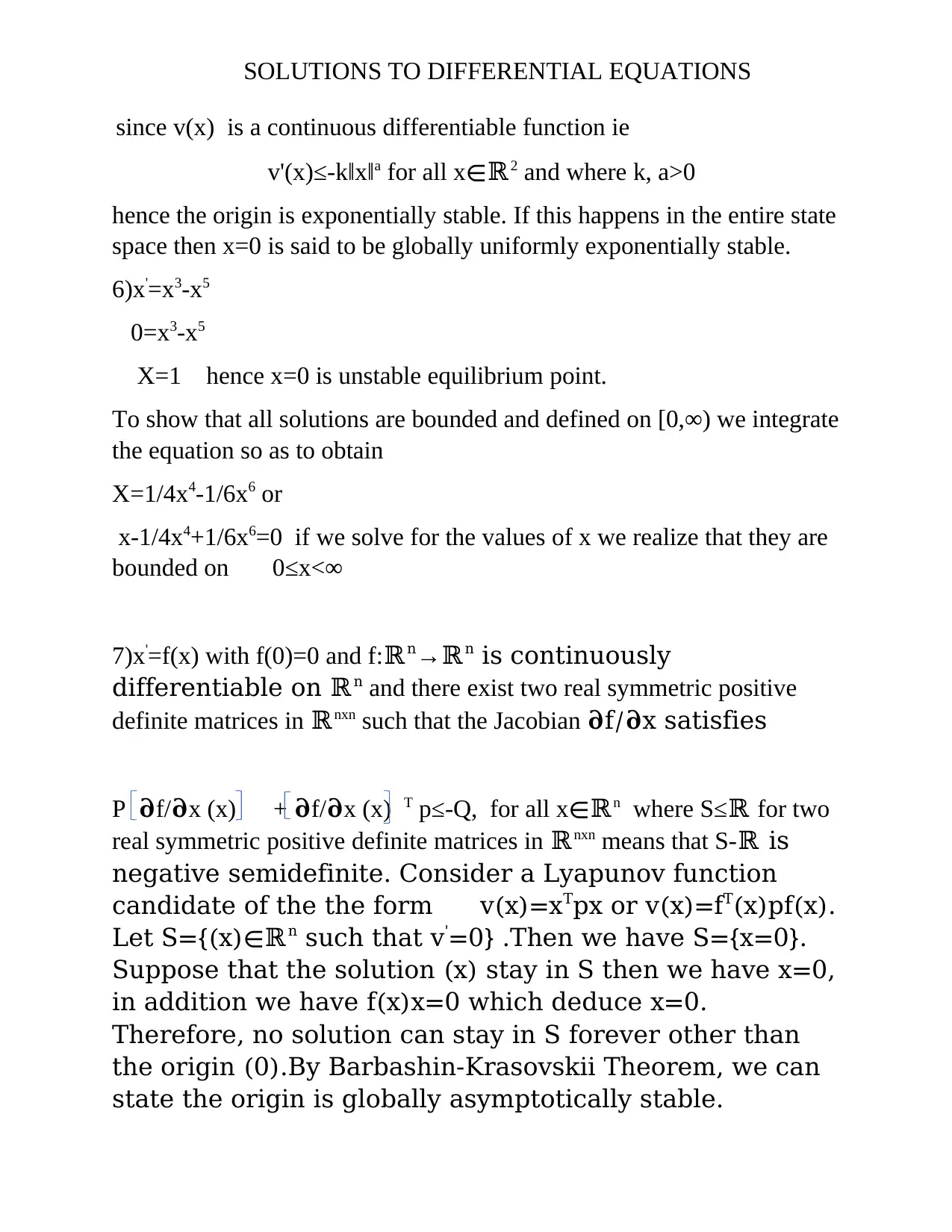
SOLUTIONS TO DIFFERENTIAL EQUATIONS
since v(x) is a continuous differentiable function ie
v'(x)≤-k‖x‖a for all x∊ℝ2 and where k, a>0
hence the origin is exponentially stable. If this happens in the entire state
space then x=0 is said to be globally uniformly exponentially stable.
6)x'=x3-x5
0=x3-x5
X=1 hence x=0 is unstable equilibrium point.
To show that all solutions are bounded and defined on [0,∞) we integrate
the equation so as to obtain
X=1/4x4-1/6x6 or
x-1/4x4+1/6x6=0 if we solve for the values of x we realize that they are
bounded on 0≤x<∞
7)x'=f(x) with f(0)=0 and f:ℝn→ℝn is continuously
differentiable on ℝn and there exist two real symmetric positive
definite matrices in ℝnxn such that the Jacobian 𝛛f/𝛛x satisfies
P 𝛛f/𝛛x (x) + 𝛛f/𝛛x (x) T p≤-Q, for all x∊ℝn where S≤ℝ for two
real symmetric positive definite matrices in ℝnxn means that S-ℝ is
negative semidefinite. Consider a Lyapunov function
candidate of the the form v(x)=xTpx or v(x)=fT(x)pf(x).
Let S={(x)∊ℝn such that v'=0} .Then we have S={x=0}.
Suppose that the solution (x) stay in S then we have x=0,
in addition we have f(x)x=0 which deduce x=0.
Therefore, no solution can stay in S forever other than
the origin (0).By Barbashin-Krasovskii Theorem, we can
state the origin is globally asymptotically stable.
since v(x) is a continuous differentiable function ie
v'(x)≤-k‖x‖a for all x∊ℝ2 and where k, a>0
hence the origin is exponentially stable. If this happens in the entire state
space then x=0 is said to be globally uniformly exponentially stable.
6)x'=x3-x5
0=x3-x5
X=1 hence x=0 is unstable equilibrium point.
To show that all solutions are bounded and defined on [0,∞) we integrate
the equation so as to obtain
X=1/4x4-1/6x6 or
x-1/4x4+1/6x6=0 if we solve for the values of x we realize that they are
bounded on 0≤x<∞
7)x'=f(x) with f(0)=0 and f:ℝn→ℝn is continuously
differentiable on ℝn and there exist two real symmetric positive
definite matrices in ℝnxn such that the Jacobian 𝛛f/𝛛x satisfies
P 𝛛f/𝛛x (x) + 𝛛f/𝛛x (x) T p≤-Q, for all x∊ℝn where S≤ℝ for two
real symmetric positive definite matrices in ℝnxn means that S-ℝ is
negative semidefinite. Consider a Lyapunov function
candidate of the the form v(x)=xTpx or v(x)=fT(x)pf(x).
Let S={(x)∊ℝn such that v'=0} .Then we have S={x=0}.
Suppose that the solution (x) stay in S then we have x=0,
in addition we have f(x)x=0 which deduce x=0.
Therefore, no solution can stay in S forever other than
the origin (0).By Barbashin-Krasovskii Theorem, we can
state the origin is globally asymptotically stable.
Paraphrase This Document
Need a fresh take? Get an instant paraphrase of this document with our AI Paraphraser
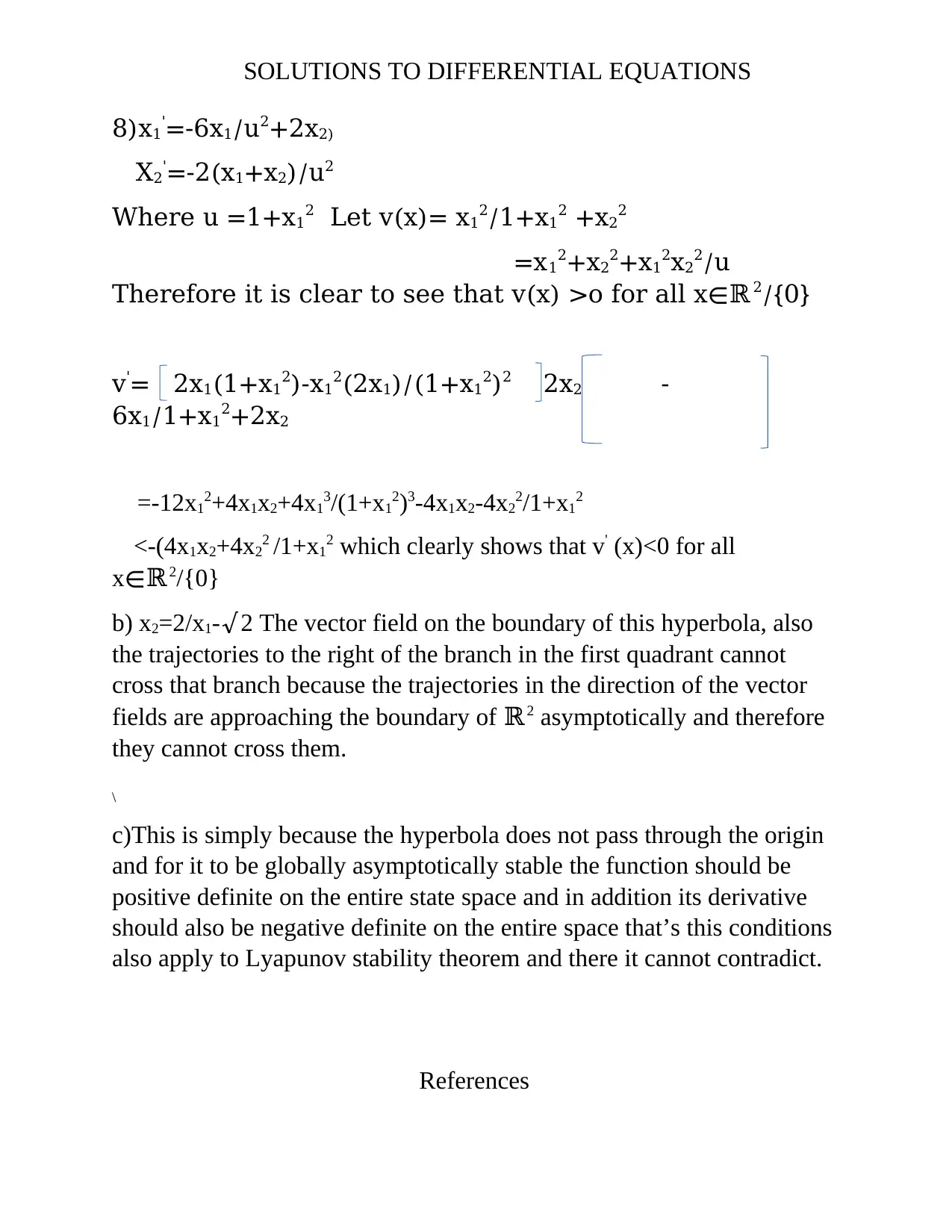
SOLUTIONS TO DIFFERENTIAL EQUATIONS
8)x1'=-6x1/u2+2x2)
X2'=-2(x1+x2)/u2
Where u =1+x12 Let v(x)= x12/1+x12 +x22
=x12+x22+x12x22/u
Therefore it is clear to see that v(x) >o for all x∊ℝ2/{0}
v'= 2x1(1+x12)-x12(2x1)/(1+x12)2 2x2 -
6x1/1+x12+2x2
=-12x12+4x1x2+4x13/(1+x12)3-4x1x2-4x22/1+x12
<-(4x1x2+4x22 /1+x12 which clearly shows that v' (x)<0 for all
x∊ℝ2/{0}
b) x2=2/x1-√ 2 The vector field on the boundary of this hyperbola, also
the trajectories to the right of the branch in the first quadrant cannot
cross that branch because the trajectories in the direction of the vector
fields are approaching the boundary of ℝ2 asymptotically and therefore
they cannot cross them.
\
c)This is simply because the hyperbola does not pass through the origin
and for it to be globally asymptotically stable the function should be
positive definite on the entire state space and in addition its derivative
should also be negative definite on the entire space that’s this conditions
also apply to Lyapunov stability theorem and there it cannot contradict.
References
8)x1'=-6x1/u2+2x2)
X2'=-2(x1+x2)/u2
Where u =1+x12 Let v(x)= x12/1+x12 +x22
=x12+x22+x12x22/u
Therefore it is clear to see that v(x) >o for all x∊ℝ2/{0}
v'= 2x1(1+x12)-x12(2x1)/(1+x12)2 2x2 -
6x1/1+x12+2x2
=-12x12+4x1x2+4x13/(1+x12)3-4x1x2-4x22/1+x12
<-(4x1x2+4x22 /1+x12 which clearly shows that v' (x)<0 for all
x∊ℝ2/{0}
b) x2=2/x1-√ 2 The vector field on the boundary of this hyperbola, also
the trajectories to the right of the branch in the first quadrant cannot
cross that branch because the trajectories in the direction of the vector
fields are approaching the boundary of ℝ2 asymptotically and therefore
they cannot cross them.
\
c)This is simply because the hyperbola does not pass through the origin
and for it to be globally asymptotically stable the function should be
positive definite on the entire state space and in addition its derivative
should also be negative definite on the entire space that’s this conditions
also apply to Lyapunov stability theorem and there it cannot contradict.
References

SOLUTIONS TO DIFFERENTIAL EQUATIONS
1. V. M. ALEKSEEV, An estimate for the perturbations of the
solutions of ordinary differen tial equations, Vestnik Moskou. Univ.
Ser. I. Math. Mekh, 2 (1961), 28-36. [Russian]
2. Z. S. ATHANASSOV, Perturbation theorems for nonlinear
systems of ordinary differential
equations, J. Math. Anal. Appl. 86 (1982), 194-207.
3. I. BIHARI, A generalization of a lemma of Bellman and its
application to uniqueness
problems of differential equations, Acta Math. Hungar. 7 (1956),
71-94.
4. G. BIRKHOFF AND G.-C. ROTA, “Ordinary Differential
Equations,” 3rd ed., Wiley, New
York, 1978.
5. F. BRAUER, Perturbations of nonlinear systems of differential
equations, J. Math. Anal.
Appl. 14 (1967), 198-206.
6. F. BRAUER, Perturbations of nonlinear systems of differential
equations, II, J. Mad Anal.
Appl. 17 (1967), 418434.
LIPSCHITZ STABILITY OF NONLINEAR SYSTEMS
577
7. F.
BRAUER AND
A.
STRAUSS,
1. V. M. ALEKSEEV, An estimate for the perturbations of the
solutions of ordinary differen tial equations, Vestnik Moskou. Univ.
Ser. I. Math. Mekh, 2 (1961), 28-36. [Russian]
2. Z. S. ATHANASSOV, Perturbation theorems for nonlinear
systems of ordinary differential
equations, J. Math. Anal. Appl. 86 (1982), 194-207.
3. I. BIHARI, A generalization of a lemma of Bellman and its
application to uniqueness
problems of differential equations, Acta Math. Hungar. 7 (1956),
71-94.
4. G. BIRKHOFF AND G.-C. ROTA, “Ordinary Differential
Equations,” 3rd ed., Wiley, New
York, 1978.
5. F. BRAUER, Perturbations of nonlinear systems of differential
equations, J. Math. Anal.
Appl. 14 (1967), 198-206.
6. F. BRAUER, Perturbations of nonlinear systems of differential
equations, II, J. Mad Anal.
Appl. 17 (1967), 418434.
LIPSCHITZ STABILITY OF NONLINEAR SYSTEMS
577
7. F.
BRAUER AND
A.
STRAUSS,
⊘ This is a preview!⊘
Do you want full access?
Subscribe today to unlock all pages.

Trusted by 1+ million students worldwide
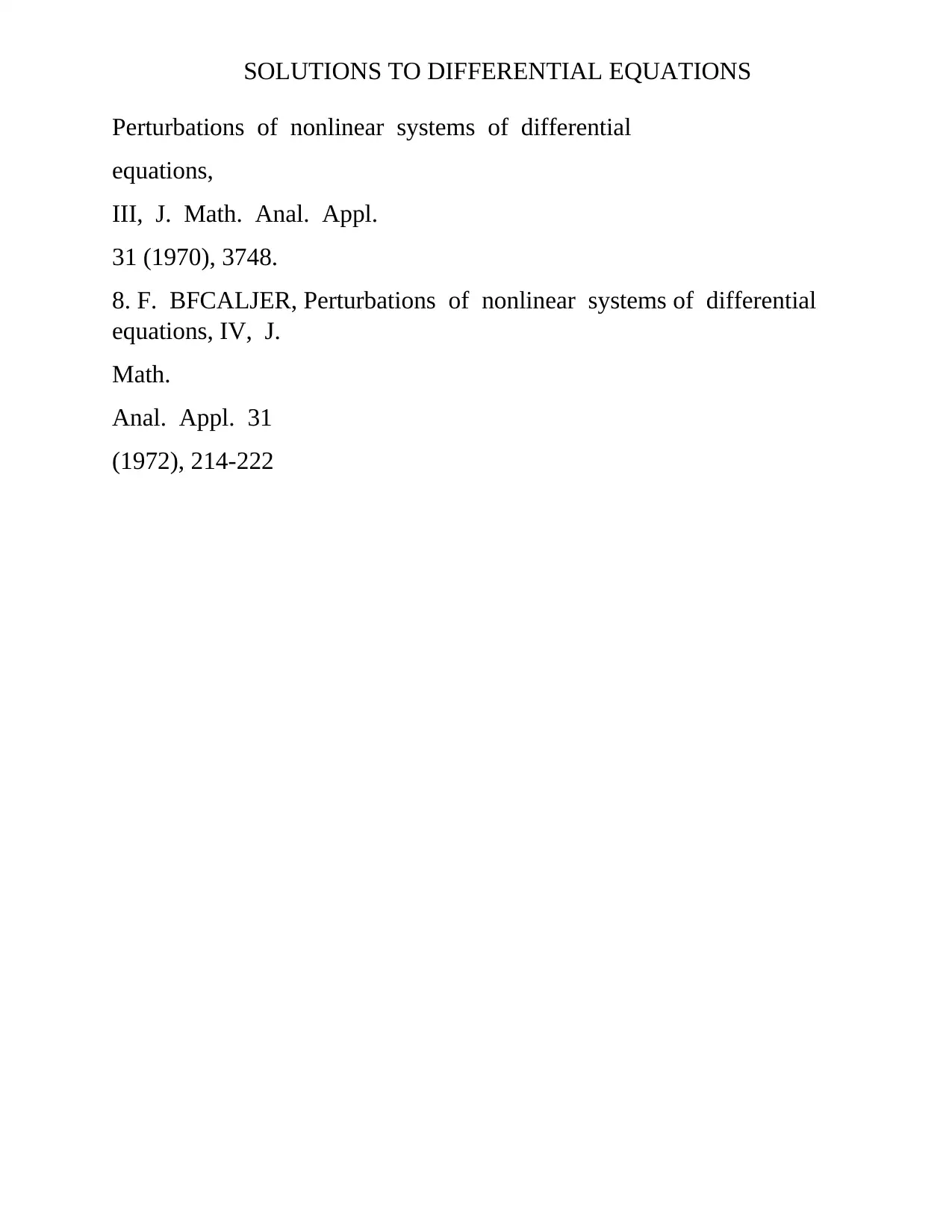
SOLUTIONS TO DIFFERENTIAL EQUATIONS
Perturbations of nonlinear systems of differential
equations,
III, J. Math. Anal. Appl.
31 (1970), 3748.
8. F. BFCALJER, Perturbations of nonlinear systems of differential
equations, IV, J.
Math.
Anal. Appl. 31
(1972), 214-222
Perturbations of nonlinear systems of differential
equations,
III, J. Math. Anal. Appl.
31 (1970), 3748.
8. F. BFCALJER, Perturbations of nonlinear systems of differential
equations, IV, J.
Math.
Anal. Appl. 31
(1972), 214-222
1 out of 10
Your All-in-One AI-Powered Toolkit for Academic Success.
+13062052269
info@desklib.com
Available 24*7 on WhatsApp / Email
![[object Object]](/_next/static/media/star-bottom.7253800d.svg)
Unlock your academic potential
Copyright © 2020–2025 A2Z Services. All Rights Reserved. Developed and managed by ZUCOL.
